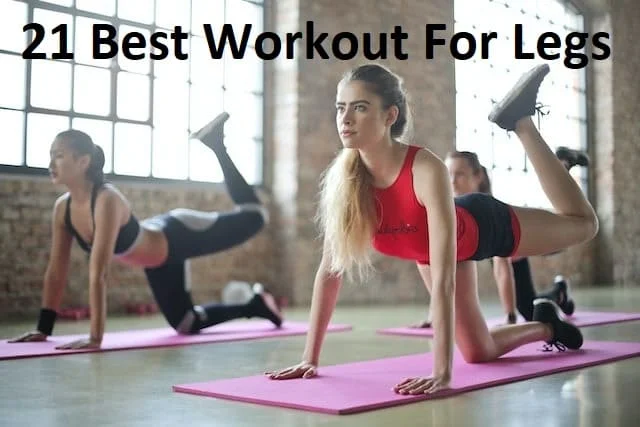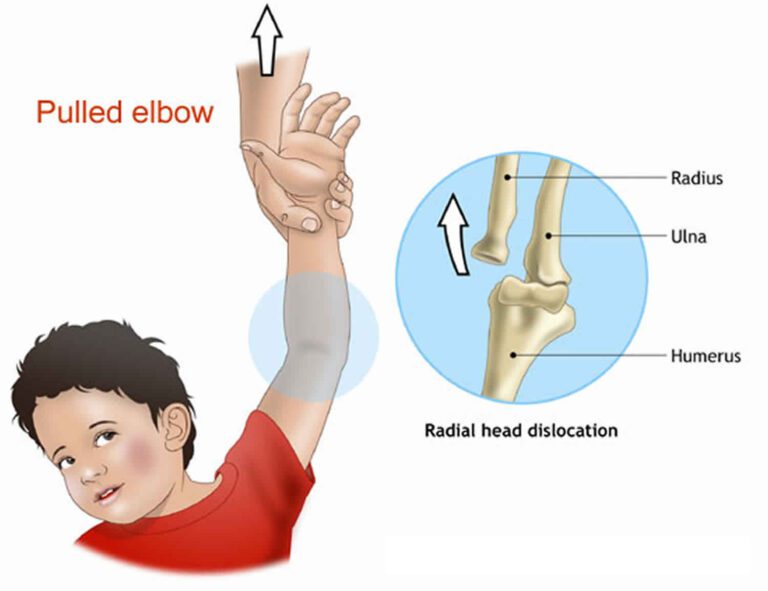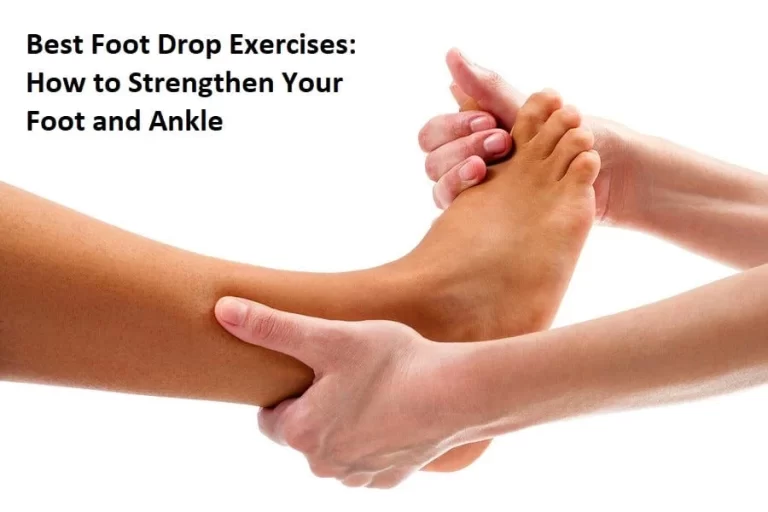21 Best Workout For Legs
A well-rounded fitness routine involves targeting various muscle groups, and when it comes to lower body strength and stability, focusing on the legs is paramount.
Leg workouts not only contribute to enhanced athletic performance and functional strength but also play a significant role in maintaining overall balance and posture. Whether you’re an athlete looking to boost your performance, a fitness enthusiast aiming for toned and strong legs, or simply seeking to improve your everyday mobility, a carefully structured leg workout can bring you remarkable results.
In this guide, we’ll delve into some of the best workouts for legs that cater to different fitness levels and goals, helping you sculpt powerful and resilient lower limbs.
Table of Contents
Why Is Leg Day Important?
Leg days are usually the hardest for lifters but also the most productive.
The muscles in your legs will help you burn more calories and maintain a high metabolism for hours following working out because they make up half of the body’s weight and have the largest muscle groups.
Benefits Of Leg Workout:
- Increases calorie burn
- Legs are toned and sculpted
- Increases general fitness
- Reduces inflammation and discomfort in the joints
- Increases mental function
- Bolsters the bones
Warm-Up and Recovery Period:
Warm-up and recovery are crucial components of any effective leg workout routine. Proper warm-up helps to prepare your muscles, increase blood flow, and reduce the risk of injury. On the other hand, proper recovery techniques aid in reducing muscle soreness, promoting circulation, and aiding in overall muscle repair. Here’s a guide to warm-up and recovery for your leg workout:
Warm-up:
Cardiovascular Warm-Up: Start with 5-10 minutes of light cardio, such as jogging, brisk walking, or cycling. This increases your heart rate and helps warm up your entire body.
Dynamic Stretching: Follow cardio with dynamic stretches that target the muscles you’ll be working. These stretches involve controlled movements that mimic the exercise motions. For example, leg swings, hip circles, and leg lunges are good choices.
Activation Exercises: Perform exercises that activate the muscles you’ll be focusing on during your leg workout. These can include bodyweight squats, leg raises, or hip bridges.
Specific Warm-Up Sets: If you’re going to do heavy lifting or intense leg exercises, start with lighter weights and gradually increase the weight in a few sets. This prepares your muscles for the upcoming workload.
Recovery:
Cool Down: After your leg workout, engage in 5-10 minutes of light cardio or low-intensity exercises. Your pulse will progressively drop as a result.
Static Stretching: Perform static stretches for the muscles you worked on. While jumping, maintain each stretch for 15 to 30 seconds. Pay attention to your calves, hip flexors, hamstrings, and quadriceps.
Foam rolling: To focus on tight muscles and relieve stress in your leg muscles, utilize a foam roller. Any regions that seem especially tight or sore should receive further attention.
Hydration and Nutrition: Rehydrate with water and consume a balanced post-workout meal that includes protein and carbohydrates to aid in muscle recovery.
Rest and Sleep: Allow your muscles to recover by getting enough sleep. For total recuperation and muscle restoration, sleep is crucial.
Active Recovery: Engage in low-intensity activities like walking or gentle cycling on your rest days to keep blood flowing and aid in recovery.
Massage or Self-Myofascial Release: Consider getting a massage or using tools like massage sticks or balls to target specific muscle groups and promote circulation.
Best Workout For Legs
Front Squat
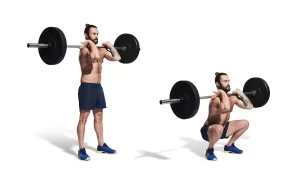
- How to do it:
- Place a barbell at roughly shoulder height on an exercise rack.
- Lift your elbows till your upper arms are parallel to the floor as you grab the power with a direct grasp at shoulder width.
- Remove the bar from the rack, then place it on the palm of your hand.
- During the entire movement, your elbows should be fully extended.
- Keeping your feet shoulder-width apart with your backs turned out, take a step back.
- To maintain the curve in your lower back, squat down as much as you can.
Bulgarian Split Squat

- How to do it:
- Before a bench, crouch at a long length.
- Your left foot’s top should be resting on the seat beside you as you grasp a dumbbell in each hand.
- Your body should be lowered until your front thigh is parallel to the ground and your back knee is almost touching it. Strength gains can be noticeable even with just one leg.
Romanian Deadlift

- How to do it:
- Holding a barbell with a shoulder-width grip while standing with your feet hip-width apart is an excellent deadlift variant.
- Try to extend the possible hip flexion.
- While lowering the bar down your shins until you feel some tension in your hamstrings, you should feel free to flex your knees as necessary.
- Maintain your lower back’s normal curve continuously.
Barbell Squat
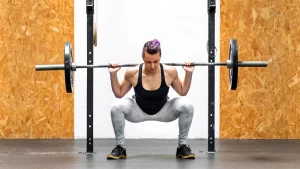
- How to do it:
- Grab the bar in a squat rack or box as widely apart as you can comfortably do so, then step under it.
- Put the bar on your lower traps, tense your shoulders, raise your elbows, and push the bar out of the rack.
- Step back a few steps and then pose with your feet shoulder-width apart and your toes pointed slightly outward.
- Taking a deep breath, bending your hips back, and bending your knees will allow you to lower your body as much as you can without maintaining the curve in your lower back.
- As you drop, extend your knees.
- Pushing your legs out, drive your hips straight to stand back up.
Deadlift
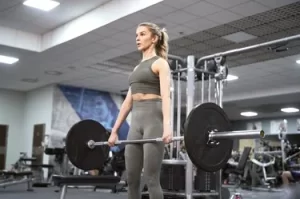
- How to do it:
- Standing upright, with your feet hip-width apart and your shins one inch from the bar, is best.
- Knees should be bent and pushed into your erect position as you hold the bar with a double-pronated or reverse grip.
- As much as you can, lift your chest, and maintain a straight-ahead gaze. As you stand up while maintaining a flat back, drag the bar upwards with your legs locked out.
- Once you’ve gotten that down, try these four methods to break your previous deadlift goal.
Leg Press

- How to do it:
- To sit easily, position the machine’s seat so that your hips are below your knees and your knees are parallel to your feet.
- When your knees are 90 degrees bent towards your chest, release the safety straps and press yourself back up.
- Avoid squatting too low to avoid having your lower back fall off the seat, which could result in injury.
Bodyweight Calf Raise
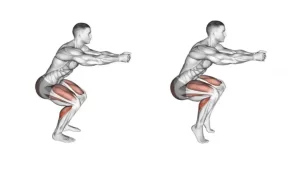
- How to do it:
- Grab anything solid for support while standing with your toes on the block.
- Lift your heels until you are standing on the balls of your feet, then slowly bring them back down until your calves are being stretched.
- This is but one method to develop stronger, larger calves.
Kettlebell Swing
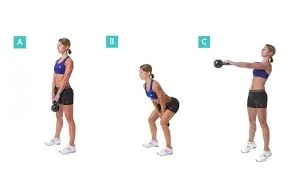
- How to do it:
- Place the kettlebell on the ground while standing with your feet hip-width apart.
- Keeping your palms facing up, grab a grip of the weight and raise it off the floor by raising your hips and keeping your lower back flat.
- The weight should then fall back between your legs as you take a deep inhale and arch your hips back.
- Exhale while extending your hips rapidly to allow the weight to move up to shoulder level.
- Control the decline while utilizing the momentum to start the following rep.
Single-leg Glute Bridge
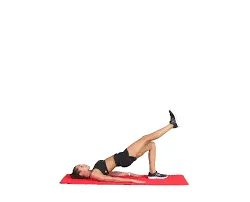
- How to do it:
- Lower both knees while lying on your back on the floor so that your feet are near your butt.
- Lift one leg and pull the knee to your chest while bracing your abs.
- Put the other foot’s heel down on the ground.
- You should straighten your body out by bridging up.
Reverse Table-Up

- How to do it:
- With your fingers pointing forward, sit on the ground with your hands beneath your shoulders.
- Spread your feet out, then tighten your glutes.
- As you cross your hips up, drive into your heels.
- Your back and hips should be parallel to the ground, forming the shape of a table.
- Take a two-second hold.
Reverse lunge
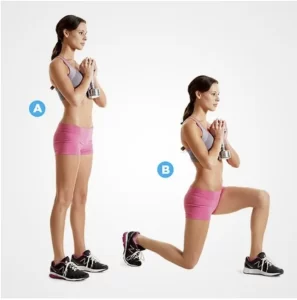
- How to do it:
- Standing with your feet shoulder-width apart and your arms at your sides is the proper posture.
- On your right foot, take a step backward and lunge forward until your left leg is at a 90-degree angle. Maintain a straight torso.
- To get back to the beginning position, push up with your left heel.
Lateral lunge
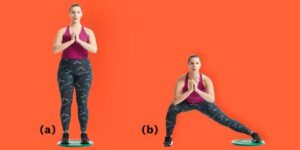
- How to do it:
- Begin by setting your feet away so they are hip distance apart.
- While keeping your body erect and sitting back on your left hip, bend your left knee. As you keep your right leg as straight as you can, lower yourself onto your left leg until your knee is at a 90-degree angle.
- Return to the beginning posture by raising yourself again. Repeat each side for the appropriate number of times.
Leg curl
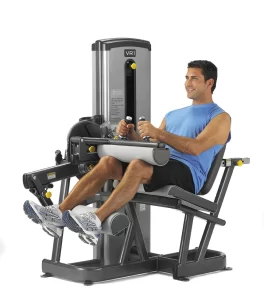
- How to do it:
- Lay flat on your stomach within the leg curl machine with the roller pad right above your heels.
- Take hold of the machine’s support bars on either side.
- By contracting your abdominal muscles and elevating your feet, pull the pad towards your butt.
- At the top, pause for a while, then slowly and deliberately return to the starting position.
Single-leg deadlift

- How to do it:
- Grasp a set of dumbbells. Throughout the exercise, maintain a straight back and a fixed gaze.
- Transfer the load to your left leg as you start to hinge at the waist while keeping your left knee flexible.
- Up till your body is in an upright position from head to toe, keep your body in a forward hinge and lift your right leg up and back. Ensure that your hips stay parallel to the ground.
- Take a moment, then start again from where you left off. Rep to each leg for the specified amount of time.
Donkey Kick
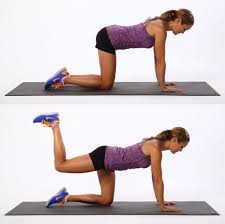
- How to do it:
- Start on the floor with your knees and hands below your hips and shoulders. Possibility of lowering to forearms
- Raise the left leg till the right toe is pointed upward and the leg is straight with the shoulders and back while maintaining the right knee bent at a 90-degree angle.
- To get back to the beginning, reverse the motion. It’s one rep.
- Once you’ve finished all the rounds on your right side, switch legs.
Goblet Squat
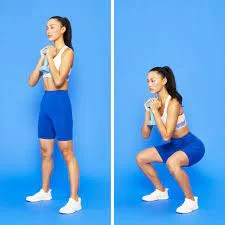
- How to do it:
- With your elbows pointed down towards the floor, grip a weight in front of your chest while standing with your feet hip-width apart.
- Lower into a squat by pushing hips back and bending knees.
- Activate your glutes to stand back up. It’s one rep.
Curtsy Lunge
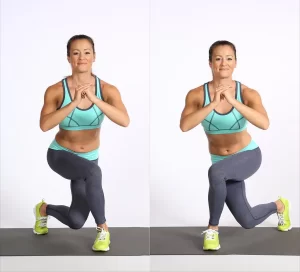
- How to do it:
- Holding one dumbbell in front of your chest, stand with your feet shoulder-width apart.
- As you progressively sit your hips back into a squat position, step your right leg back diagonally outside your left leg.
- To get back to standing, turn the motion around.
- As you progressively sit your hips back into a squat position, step your left leg back diagonally outside your right leg. It’s one rep.
- Legs are alternated again.
Pistol Squat

- How to do it:
- Start by assuming a hip-distance posture.
- Bring the body down as much as possible while maintaining an upright posture by lifting the right leg while sitting with the hips back and bending the left knee. For balance, the arms can be held out to the sides or in front of the chest.
- Pushing through the left heel, get up to go back to the beginning. It’s one rep.
Banded Kickback
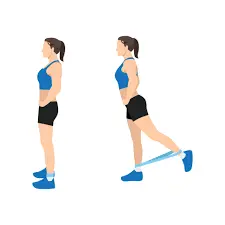
- How to do it:
- Begin on your knees and hands.
- Place the mini band just above the knee on the left leg, with the other end on the right foot.
- Keeping your core firm, slowly kick your right leg back until it is straight by contracting your glutes.
- Squeeze glutes for a brief period when fully extended.
- Recover your leg gradually. It’s one rep.
Step up

- How to do it:
- A bench or other high surface should be approximately one foot in front of you as you stand. If you wish to perform a weighted step-up, grip a dumbbell in each hand.
- To add to the challenges, elevate your left knee as you step onto the bench with your complete right foot, pushing up with your heel to bring your left foot to meet your right foot.
- Make a step back using your left foot to return to the starting position.
Jump Squat
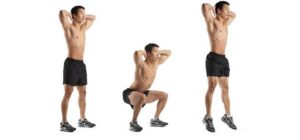
- How to do it:
- Start by standing with your feet shoulder-width apart or hip-width apart.
- As though you were about to sit down on a seat before you, lower yourself down and back up by hingeing at the hips.
- Once you reach the required depth (no deeper than thighs parallel to the ground), let your knees bend as your hips drive back. Depending on an individual’s anatomy, mobility, and lower-body power, depth will change. Your range ends when your knees start to move forward.
- Leap up quickly from the lowest position for height. To safeguard your joints, land gently. It’s one rep.
Summary
A leg workout typically focuses on targeting and strengthening the muscles in the lower body, including the quadriceps, hamstrings, glutes, and calves. These exercises can help improve lower body strength, stability, and overall athletic performance. A well-rounded leg workout often includes a combination of compound movements and isolation exercises to effectively work for different muscle groups.
Some common leg exercises include squats, lunges, deadlifts, leg presses, calf raises, and hamstring curls. It’s important to warm up before starting your workout and to use proper form to prevent injuries. Varying the intensity, reps, and sets in your leg routine can help you achieve your fitness goals and continue making progress over time.
FAQs:
Your state of fitness and goals will determine how often you should do leg exercises. Generally, 2-3 times a week is recommended for most people. It’s essential to give yourself enough time between workouts to recover and rest, too.
Ensure proper form and alignment, don’t let your knees go past your toes during squats and lunges, and avoid excessive load or sudden increases in weight. Also, make sure to warm up properly before starting your leg workout.
It’s beneficial to incorporate a mix of both. High-rep sets can improve muscular endurance, while heavy weights with lower reps are better for building strength and muscle mass.
Retaining flexibility and avoiding tightness in the muscles requires stretching. Include static stretches for major leg muscle groups after your workout, when your muscles are warm.
To prevent injuries, make sure to use proper form, warm up before starting, and gradually increase weights and intensity. Never exert yourself too severely and pay attention to your body.

